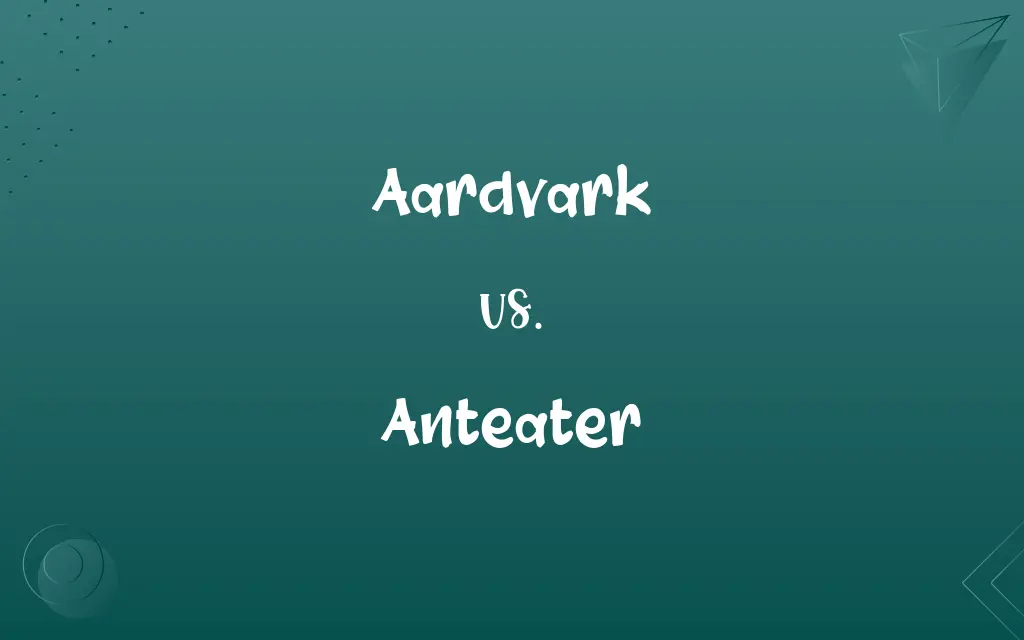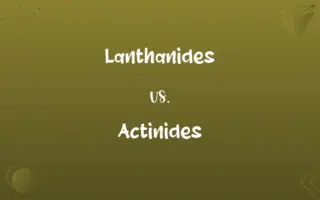Aardvark vs. Anteater: Know the Difference

By Shumaila Saeed || Published on February 26, 2024
Aardvarks are nocturnal mammals from Africa known for their digging abilities, while anteaters are South American mammals with elongated snouts for eating ants and termites.

Key Differences
The Aardvark, native to Africa, is a solitary, nocturnal mammal recognized by its pig-like snout and powerful digging claws. In contrast, Anteaters, found in Central and South America, are known for their elongated snouts and long, bushy tails. Both animals share a diet primarily consisting of ants and termites, but their physical appearances and habitats are markedly different.
Shumaila Saeed
Feb 26, 2024
Aardvarks possess a unique dentition; they lack incisors and canines, and their teeth lack enamel and continuously grow. Anteaters, on the other hand, are completely toothless. They rely on their long, sticky tongues to capture ants and termites. While both use their keen sense of smell to locate food, their feeding methods and mouth structures differ significantly.
Shumaila Saeed
Feb 26, 2024
In terms of habitat, Aardvarks are adaptable and can be found in various environments, from savannas to rainforests across Africa. Anteaters prefer habitats ranging from dry tropical forests to rainforests and grasslands in their American range. This difference in habitat reflects their adaptation to different ecosystems.
Shumaila Saeed
Feb 26, 2024
The Aardvark's body is covered in coarse hair, and they are adept at digging burrows for living and searching for food. Anteaters have dense fur and are more adapted to a wandering lifestyle, with some species like the Giant Anteater having no permanent den. Both animals' lifestyles are deeply influenced by their primary food source – insects.
Shumaila Saeed
Feb 26, 2024
Reproduction in Aardvarks results in a single offspring after a gestation period of about seven months. Anteaters, particularly the Giant Anteater, also typically give birth to one offspring, but with varying gestation periods depending on the species. The caring of young in both species exhibits unique parental behaviors tailored to their respective environments.
Shumaila Saeed
Feb 26, 2024
ADVERTISEMENT
Comparison Chart
Physical Appearance
Pig-like snout, powerful claws
Elongated snout, bushy tail
Shumaila Saeed
Feb 26, 2024
Teeth
Lacks incisors and canines, continuously growing teeth
Completely toothless
Shumaila Saeed
Feb 26, 2024
Habitat Preference
Savannas, rainforests
Dry forests, rainforests, grasslands
Shumaila Saeed
Feb 26, 2024
Reproduction and Offspring
Single offspring, 7-month gestation
Single offspring, varied gestation periods
Shumaila Saeed
Feb 26, 2024
ADVERTISEMENT
Aardvark and Anteater Definitions
Aardvark
A nocturnal, insectivorous mammal native to Africa with a pig-like snout.
The aardvark used its strong claws to dig into the termite mound.
Shumaila Saeed
Jan 12, 2024
Anteater
A toothless, insectivorous mammal from Central and South America with a long snout.
The anteater used its elongated tongue to feed on ants in the log.
Shumaila Saeed
Jan 12, 2024
Aardvark
Known for its powerful digging abilities and long ears.
At night, the aardvark dug extensive burrows in search of food.
Shumaila Saeed
Jan 12, 2024
Anteater
Known for its dense fur and bushy tail.
The anteater’s bushy tail helped it balance in the tree branches.
Shumaila Saeed
Jan 12, 2024
Aardvark
Has a diet primarily of ants and termites.
The aardvark's long tongue was perfect for lapping up ants.
Shumaila Saeed
Jan 12, 2024
ADVERTISEMENT
Anteater
Includes species like the Giant Anteater, which has no permanent den.
The Giant Anteater roamed the grasslands, foraging for food without a specific home.
Shumaila Saeed
Jan 12, 2024
Aardvark
Possesses a unique dental structure without incisors or canines.
The aardvark's teeth are adapted to its insectivorous diet.
Shumaila Saeed
Jan 12, 2024
Anteater
Any of several Central and South American mammals of the suborder Vermilingua that lack teeth and feed on ants and termites, especially the giant anteater.
Shumaila Saeed
Jan 10, 2024
Aardvark
Solitary animal, often found in self-made burrows.
The solitary aardvark spent most of its day in its burrow, emerging at night to feed.
Shumaila Saeed
Jan 12, 2024
Anteater
Any of several other animals, including the echidna, aardvark, and pangolin, that feed on ants.
Shumaila Saeed
Jan 10, 2024
Aardvark
A burrowing mammal (Orycteropus afer) of sub-Saharan Africa, having a stocky body, large ears, a long tubular snout, and powerful digging claws for feeding on ants and termites.
Shumaila Saeed
Jan 10, 2024
Anteater
Any of several animals of South and Central America, in suborder Vermilingua, which are noted for eating ants and termites which they catch with their long sticky tongues.
Shumaila Saeed
Jan 10, 2024
Aardvark
The nocturnal, insectivorous, burrowing, mammal Orycteropus afer, of the order Tubulidentata, somewhat resembling a pig, common in some parts of sub-Saharan Africa.
The aardvark burrows in the ground and feeds mostly on termites, which it catches with its long, slimy tongue.
Shumaila Saeed
Jan 10, 2024
Anteater
Any of some other not closely related species that feed with ants, including pangolin (scaly anteater), echidna (spiny anteater), aardvark and numbat (banded anteater).
Shumaila Saeed
Jan 10, 2024
Aardvark
An edentate mammal, of the genus Orycteropus (Orycteropus afer), somewhat resembling a pig, common in some parts of Southern Africa. It is a nocturnal ungulate, burrows in the ground with its powerful claws, and feeds entirely on ants and termites, which it catches with its long, extensile, slimy tongue. It is the sole extant representative of the order Tubulidentata.
Shumaila Saeed
Jan 10, 2024
Anteater
Toothless mammal of southern Africa and Asia having a body covered with horny scales and a long snout for feeding on ants and termites
Shumaila Saeed
Jan 10, 2024
Aardvark
Nocturnal burrowing mammal of the grasslands of Africa that feeds on termites; sole extant representative of the order Tubulidentata
Shumaila Saeed
Jan 10, 2024
Anteater
Any of several tropical American mammals of the family Myrmecophagidae which lack teeth and feed on ants and termites
Shumaila Saeed
Jan 10, 2024
Anteater
Nocturnal burrowing mammal of the grasslands of Africa that feeds on termites; sole extant representative of the order Tubulidentata
Shumaila Saeed
Jan 10, 2024
Anteater
Small Australian marsupial having long snout and strong claws for feeding on termites; nearly extinct
Shumaila Saeed
Jan 10, 2024
Anteater
Burrowing spine-covered monotreme of Australia having a long snout and claws for hunting ants and termites
Shumaila Saeed
Jan 10, 2024
Anteater
Feeds primarily on ants and termites.
An anteater can consume thousands of ants in a single day.
Shumaila Saeed
Jan 12, 2024
Anteater
Exhibits unique parental care, with offspring often riding on the mother's back.
The baby anteater clung to its mother's back as she foraged.
Shumaila Saeed
Jan 12, 2024
Repeatedly Asked Queries
What is an Anteater?
A toothless, insectivorous mammal from Central and South America, with a long snout.
Shumaila Saeed
Feb 26, 2024
What is an Aardvark?
A nocturnal, insectivorous mammal native to Africa, known for its digging abilities.
Shumaila Saeed
Feb 26, 2024
How do Aardvarks reproduce?
Typically, they have one offspring after a seven-month gestation.
Shumaila Saeed
Feb 26, 2024
Where do Aardvarks live?
In various environments across Africa, from savannas to rainforests.
Shumaila Saeed
Feb 26, 2024
Where do Anteaters live?
In habitats ranging from dry tropical forests to rainforests in the Americas.
Shumaila Saeed
Feb 26, 2024
How do Anteaters reproduce?
They give birth to one offspring, with gestation periods varying by species.
Shumaila Saeed
Feb 26, 2024
What are the main predators of Aardvarks?
Lions, leopards, and hyenas are among their predators.
Shumaila Saeed
Feb 26, 2024
How long do Anteaters live?
Their lifespan varies, but Giant Anteaters can live up to 16 years in the wild.
Shumaila Saeed
Feb 26, 2024
Do Aardvarks have teeth?
Yes, but they lack incisors and canines, and their teeth continuously grow.
Shumaila Saeed
Feb 26, 2024
Do Aardvarks have good eyesight?
Their eyesight is poor, but they have excellent hearing and smell.
Shumaila Saeed
Feb 26, 2024
Are Anteaters solitary?
Most species are solitary, except during mating or mothering.
Shumaila Saeed
Feb 26, 2024
Do Anteaters have good eyesight?
Their eyesight is not strong, but they have a keen sense of smell.
Shumaila Saeed
Feb 26, 2024
Share this page
Link for your blog / website
HTML
Link to share via messenger
About Author
Written by
Shumaila SaeedShumaila Saeed, an expert content creator with 6 years of experience, specializes in distilling complex topics into easily digestible comparisons, shining a light on the nuances that both inform and educate readers with clarity and accuracy.








































































